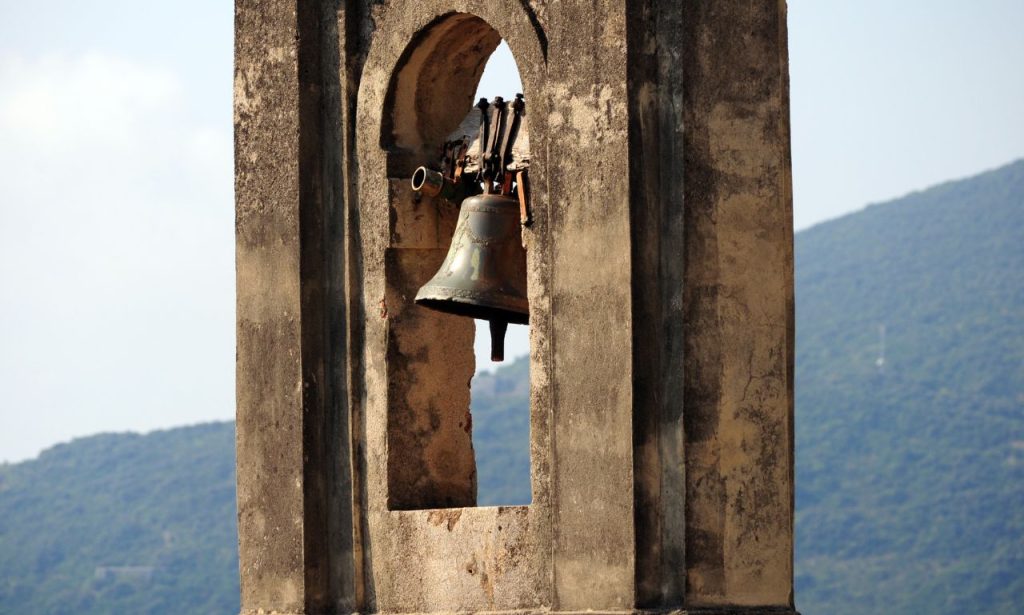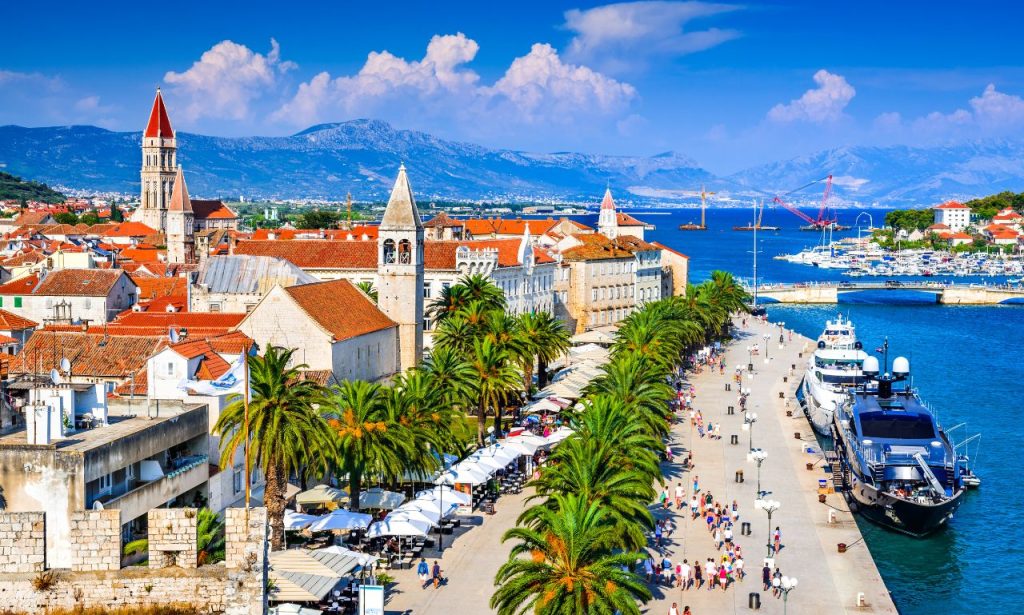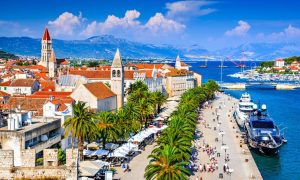Welcome to Split, Croatia’s vibrant coastal city that perfectly blends ancient history with modern Mediterranean charm! As Croatia’s second-largest city, Split offers visitors an incredible mix of Roman architecture, stunning beaches, delicious food, and unforgettable views. Whether you are planning a quick visit or an extended stay, this guide will help you discover the best things to do in Split.
Exploring Diocletian’s Palace
Start your exploration at the Bronze Gate on the southern wall. From here, you can wander through narrow streets lined with shops, cafes, and restaurants. The palace was built as a combination of a military fortress and a luxury villa, and it was divided into four quarters by two main streets.
Don’t miss the Peristyle, the central square of the Palace where Romans once gathered for ceremonies. Today, it’s the perfect spot to sit at a cafe, sip Croatian coffee, and soak in the atmosphere surrounded by ancient columns and impressive architecture.
The underground corridors in Diocletian’s Palace’s basement offer a fascinating look at the original construction. These intact subterranean spaces once protected the emperor’s upper residential sections and are now little shops selling souvenirs and local handicrafts.
Pro tip: Purchase a combined ticket that gives you access to multiple historical sites in Split, including the cellars, the Temple of Jupiter, and the Cathedral. It’s a much better value than buying individual tickets!
Climb the Cathedral Bell Tower

Adjacent to Diocletian’s Palace stands the Cathedral of Saint Domnius, one of the oldest Catholic cathedrals still in its original structure. The cathedral was built around what was originally Diocletian’s mausoleum—quite ironic considering the emperor was known for persecuting Christians.
For one of the best views in Split, tackle the climb up the cathedral’s bell tower. I won’t lie—the 183 steps are steep, narrow, and not for the faint of heart or those with mobility issues. But the reward at the top is worth it: a 360-degree panorama of Split’s terracotta rooftops, the harbor, and the islands beyond.
The steps get progressively narrower as you climb higher, and there are few resting spots. Bring water and wear comfortable shoes. The best time to climb is early morning or late afternoon to avoid crowds and the midday heat.
Discover Split’s Jewish Heritage
Split has a rich Jewish history dating back to the 3rd century. In the heart of Diocletian’s Palace, one of the smallest synagogues in Europe is tucked away on Židovski prolaz (Jewish Passage).
The Jewish community in Split has faced many challenges throughout history but has maintained its presence there for centuries. Visit the synagogue and the small Jewish museum to learn about this vital part of Split’s cultural heritage.
Nearby is the old Jewish cemetery on Marjan Hill, which offers both historical significance and beautiful views over the city.
Enjoy Sustipan at Sunset

For a magical evening experience, head to Sustipan Park on a small peninsula west of the city center. This peaceful park was once the site of a Benedictine monastery and later served as the city’s main cemetery.
Today, it’s a beautiful green space with walking paths, benches, and stunning views of the Adriatic Sea. Time your visit for sunset, when the sky turns various shades of pink and orange, casting a golden glow over the water.
Bring a picnic dinner and a bottle of local Croatian wine, and find a spot along the cliffs to watch the sun dip below the horizon. It’s a perfect way to end a day of sightseeing and one of the most romantic spots in Split.
Nighttime SUP Tour
For a unique perspective of Split, try a nighttime stand-up paddleboard (SUP) tour of the harbor. Several companies offer guided evening tours where you paddle on illuminated boards that light up the water beneath you.
Gliding across the calm evening waters with the city lights twinkling on the shore offers a magical experience that few tourists enjoy. The tours typically last about two hours and are suitable for beginners—no previous paddleboarding experience is required.
The best part? Paddling beneath the stars while looking back at the illuminated facade of Diocletian’s Palace from the water gives you a whole new appreciation for Split’s beauty.
Walk the Riva
The Riva is Split’s main waterfront promenade and the city’s social hub. This wide, palm-lined walkway stretches along the harbor and is the perfect place for the traditional Croatian pastime of “špica”—seeing and being seen.
In the morning, join locals at one of the many cafes for coffee and people-watching. During the day, the Riva offers shade and sea breezes when the city gets hot. Come evening, it transforms into a lively social scene with families, couples, and friends all enjoying the Mediterranean atmosphere.
The Riva also hosts various events throughout the year, from Christmas markets to summer festivals. No visit to Split is complete without at least one stroll along this iconic waterfront.
Hiking and Viewpoints
Multiple trails crisscross the peninsula, ranging from easy walks to more challenging hikes. Start at the Marjan Stairs near the Varoš neighborhood and climb to the first viewpoint for stunning vistas of Split and the harbor.
Continue higher to reach the Telegrin Peak, the highest point on Marjan at 178 meters above sea level. From here, you can see Split and the surrounding mountains and islands.
Hidden Beaches
One of Marjan’s best-kept secrets is its secluded beaches. Kasjuni Beach and Bene Beach offer crystal-clear waters and are far less crowded than the popular Bačvice Beach near the city center.
For a truly local experience, find the tiny Ježinac Beach tucked away between pine trees. Pack a snorkel and mask to explore the underwater world just offshore.
Cave Dwellings and Churches
Throughout Marjan, small churches and hermitage caves dating back to the Middle Ages. The 13th-century Church of St. Nicholas is particularly charming, as are the cave dwellings where hermits once lived in solitude.
The paths to these sites are well-marked, but bring water and sun protection, especially during summer.
Where to Eat
Split offers everything from traditional konobas (local taverns) to modern restaurants with innovative takes on Croatian classics.
For fresh seafood, head to Konoba Fetivi in the Varoš neighborhood. Their grilled fish, squid ink risotto, and black cuttlefish risotto are local favorites. Pair your meal with a glass of Pošip, a white wine from the nearby island of Korčula.
If you’re craving meat, try Konoba Nikola in the old town for its peak—a slow-cooked traditional dish of meat and vegetables under a bell-shaped lid. It’s usually lamb or veal; you must order it at least 3 hours before.
For a quick bite, visit the local green market (Pazar) in the morning to pick up fresh bread, cheese, prosciutto, and fruit for a picnic on Marjan or at the beach.
Don’t leave Split without trying soparnik, a Swiss chard-filled pastry that’s a specialty of the Dalmatian region, and rožata, a local custard dessert similar to crème caramel.

- Best Time to Visit: May- June and September- October offer pleasant weather and fewer crowds than the peak summer months.
- Getting Around: Split’s Old Town is compact and pedestrian-friendly. For longer distances, the city has an efficient bus system.
- Money: Croatia uses the Euro. While credit cards are widely accepted, keep some cash for smaller establishments and markets.
- Accommodation: Book accommodations well in advance, especially if visiting during the summer. Consider staying in apartments with kitchenettes for a more local experience and to save on food costs.
- Water: Tap water is perfectly safe to drink throughout Croatia, so bring a reusable water bottle and refill it to stay hydrated.
Conclusion
Split perfectly blends history, culture, natural beauty, and delicious food. Whether you want to climb the cathedral bell tower for panoramic views, wander through ancient Roman ruins, or relax on a secluded beach, Split has something for every traveler.
The city’s walkable size means you can see many highlights in just a few days, but its rich offerings could easily keep you entertained for weeks. With friendly locals, stunning architecture, and the crystal-clear Adriatic Sea, Split deserves its reputation as one of Croatia’s most captivating destinations.
ALSO READ: What to Pack for a Trip to Cancun
FAQs
Take at least 2-3 days to see the main attractions in Split. Add more days if you plan to take day trips to nearby islands or national parks.
Split is generally more affordable than Western European destinations, though prices rise during the peak summer season. Budget-conscious travelers can find good deals on accommodations and meals, especially away from the main tourist areas.
Bačvice Beach is the most popular and closest to the city center. Try the beaches along the Marjan Peninsula, like Kasjuni or Bene, for quieter options.
Yes, tap water in Split and throughout Croatia is safe to drink.
Airport buses run regularly and take about 30 minutes. Taxis and private transfers are also available but more expensive.




